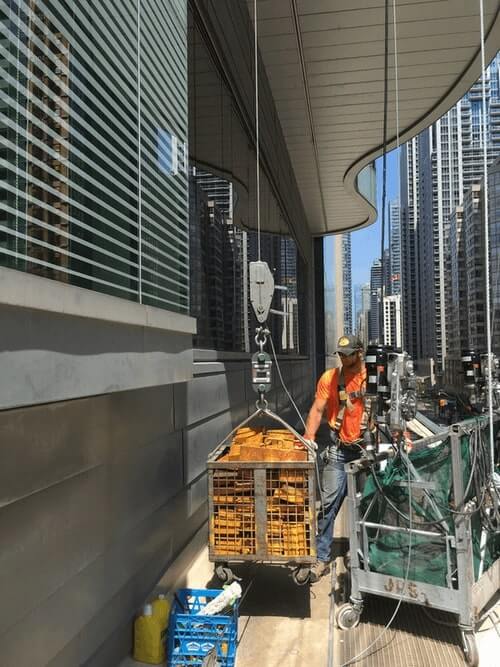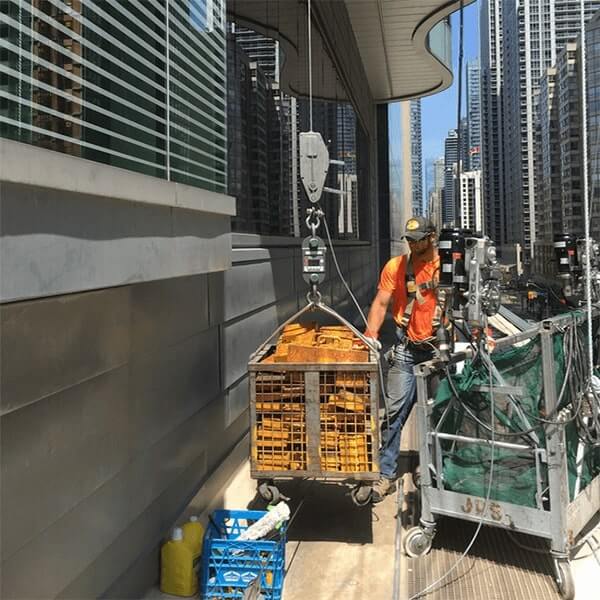Many people do not have first-hand experience with fall arrest and tieback roof anchors (for window washing systems and fall protection equipment) and are not versed in high-rate energy performance methods. Roof anchor strength and force standards are necessary for fall protection and suspended access systems. This blog explains the force and load standards set by OSHA and ANSI, the tests used to verify roof anchors, and engineering principles that ensure compliance and worker safety.

OSHA and ANSI roof anchor strength standards
An ideal fall arrest and tieback roof anchor is designed to meet the strength and force standards contained in Federal OSHA 29CFR1910.66 Appendix C.
To arrest a fall in a controlled manner, sufficient energy absorption capacity in the system is essential. Without this energy absorption, the fall can only be arrested by applying large forces to the worker and to the anchorage, which can severely affect either (or both).
A complete understanding of the “force requirement” is a complex process. A force-type review considers the energy considerations in the design of the roof anchor. These loads can be regarded as “high-rate-energy forces.” Actual loads on the user, anchorage, and structure can vary widely.
Pro-Bel offers a free design service for roof anchors
Factors Influencing Anchor Performance
The designer must recognize that the anchor, securement, and structure can see various loads because of the varying:
- user weight,
- height of fall,
- geometry, and
- type of rigging equipment used
Many do not have firsthand experience with fall arrest and tieback roof anchors (for window washing systems and fall protection equipment). They are not versed in high-rate energy performance methods. Anchors are often over- or underdesigned and may not adequately support a worker and the rigging equipment in the event of a failure.
Drop Test Procedures
Strength Test:
A test weight is dropped once using 300 pounds plus or minus 5 pounds (135 kg plus or minus 2.5 kg) and should be used to test a safety anchor.
- The drop test must be performed with a non-elastic wire rope lanyard.
- The lanyard length should be 5 feet plus or minus 2 inches (1.83 m plus or minus 5 cm) as measured from the fixed rigid anchorage.
- The test weight should fall without interference, obstruction, or hitting the floor or ground during the test.
- Any breakage or slippage that permits the weight to fall free to the ground should constitute a failure of the anchor, and therefore, the anchor does not pass the strength test.
Force Test:
It consists of dropping the respective test weight using a five-foot shock-absorbing lanyard. During the force test, the maximum elongation distance should be recorded.
- The force test intends to control and measure the applied arresting forces and loads.
- A system design fails the force test if the recorded maximum arresting force when using a body harness exceeds 2,520 pounds (11.21 kN).
The force test is often used when designing horizontal lifeline parts and components. Understanding these force principles will help designers understand the anchor performance and design.
Key Considerations for Roof Anchor Design
“Normally, this means that the anchor eye may bend or yield, yet the anchorage or structure will be protected.”
- Good design will include a safety factor or proper engineering multiple times over the allowable working load.
- Proper design will ensure that the anchor deforms to absorb energy, yet the final securement method or studs cannot fail.
Suppose redundancy is not built into the design. In that case, the critical connections must include an increased importance factor of 1.9, compared to 1. Adhesive anchors have higher design requirements due to the potential for abnormal deterioration of concrete and aging loss; redundancy in anchor bolts must also be considered.

